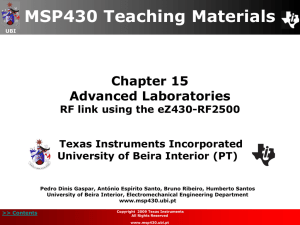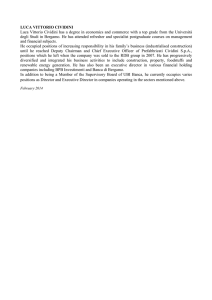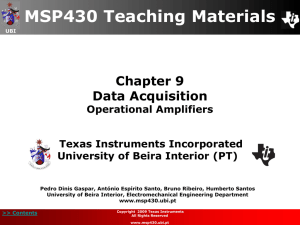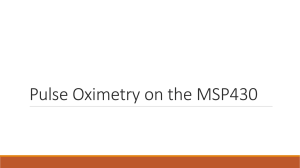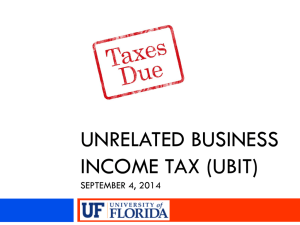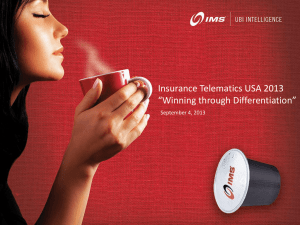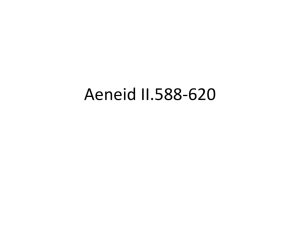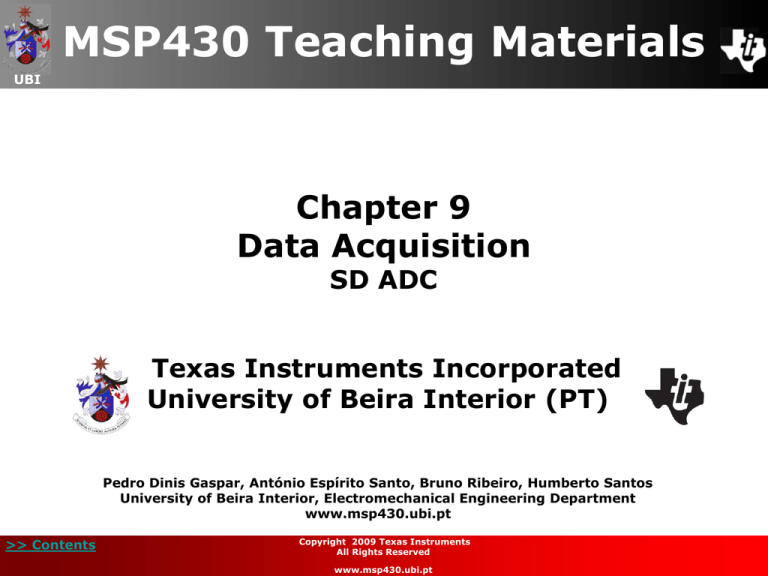
MSP430 Teaching Materials
UBI
Chapter 9
Data Acquisition
SD ADC
Texas Instruments Incorporated
University of Beira Interior (PT)
Pedro Dinis Gaspar, António Espírito Santo, Bruno Ribeiro, Humberto Santos
University of Beira Interior, Electromechanical Engineering Department
www.msp430.ubi.pt
>> Contents
Copyright 2009 Texas Instruments
All Rights Reserved
www.msp430.ubi.pt
Contents
UBI
Introduction to Sigma-Delta ADC :
Delta modulator
Digital filter
Decimation digital filter
MSP430 SD16(A) – Sigma-Delta ADC
Lab5D: SD16 Signal Acquisition
Quiz
>> Contents
Copyright 2009 Texas Instruments
All Rights Reserved
www.msp430.ubi.pt
2
Sigma-Delta ADC Introduction (1/11)
UBI
Sigma-Delta (SD) converter determines the digital word:
• By oversampling the input signal using sigma-delta
modulation;
• Applying digital filtering;
• Reducing data rate by collecting modulator output bits
(decimation).
>> Contents
Copyright 2009 Texas Instruments
All Rights Reserved
www.msp430.ubi.pt
3
Sigma-Delta ADC Introduction (2/11)
UBI
Delta modulator:
Quantizes the difference between the current analogue input
signal and the average of the previous samples.
Example: 1st order modulator (simplest form):
• Quantization (comparator): Output={1,0} if Input={+,-}
• Demodulator (integrator - 1 bit DAC): Output={,} if
Input={1,0}.
>> Contents
Copyright 2009 Texas Instruments
All Rights Reserved
www.msp430.ubi.pt
4
Sigma-Delta ADC Introduction (3/11)
UBI
Delta modulator:
Density of “1’s" at the modulator OUT is proportional to IN
signal:
• Increasing IN, the comparator generates a greater number
of “1’s";
• Decreasing IN, the comparator generates a lesser number
of “1’s".
By summing the error voltage, the integrator acts as a:
• Lowpass filter for the input signal;
• Highpass filter for the quantization noise.
>> Contents
Copyright 2009 Texas Instruments
All Rights Reserved
www.msp430.ubi.pt
5
Sigma-Delta ADC Introduction (4/11)
UBI
Delta modulator:
Most quantization noise is pushed into higher frequencies;
Oversampling changes noise distribution (but not total noise);
Quantization noise limits the dynamic range of the ADC;
Noise is the “round-off” error of analogue signal quantization.
>> Contents
Copyright 2009 Texas Instruments
All Rights Reserved
www.msp430.ubi.pt
6
Sigma-Delta ADC Introduction (5/11)
UBI
Delta modulator:
As the OSR (Over-Sampling Ratio) increases, the noise
decreases (SNR increases);
As the order of the modulator increases, the noise decreases.
>> Contents
Copyright 2009 Texas Instruments
All Rights Reserved
www.msp430.ubi.pt
7
Sigma-Delta ADC Introduction (6/11)
UBI
Digital Filter:
Averages the 1-bit data stream;
Improves the analogue to digital conversion resolution;
Removes quantization noise outside the band of interest;
Determines signal bandwidth, settling time and stopband
rejection.
>> Contents
Copyright 2009 Texas Instruments
All Rights Reserved
www.msp430.ubi.pt
8
Sigma-Delta ADC Introduction (7/11)
UBI
Digital Filter:
There are several types of digital filters:
• Finite Impulse Response (FIR) filter: output is
dependent only on past and present values of the input;
• Sinc filter: Removes all frequency components above a
given bandwidth, leaving the the low frequency
components. It has linear phase;
• Infinite Impulse Response (IIR) filter: the output is
dependent on past and present values of both the input and
the output;
• Averaging, Moving average filter.
>> Contents
Copyright 2009 Texas Instruments
All Rights Reserved
www.msp430.ubi.pt
9
Sigma-Delta ADC Introduction (8/11)
UBI
Digital Filter:
SD converters: widely used lowpass filter: Sinc³ or Sinc5 types.
>> Contents
Copyright 2009 Texas Instruments
All Rights Reserved
www.msp430.ubi.pt
10
Sigma-Delta ADC Introduction (9/11)
UBI
Digital Filter:
Main advantage of Sinc filter: notch response. The notch
position is directly related to the output data rate, allowing
high frequency noise reduction and 60 Hz mains.
>> Contents
Copyright 2009 Texas Instruments
All Rights Reserved
www.msp430.ubi.pt
11
Sigma-Delta ADC Introduction (10/11)
UBI
Digital Filter:
The output of the digital filter will be a data stream:
>> Contents
Copyright 2009 Texas Instruments
All Rights Reserved
www.msp430.ubi.pt
12
Sigma-Delta ADC Introduction (11/11)
UBI
Decimation Digital Filter:
Decimation: Reduces the sampling rate down from the
oversampling rate without losing information (eliminates
redundant data);
Using the Nyquist theorem (fsample > 2finput) and the
oversampling at the delta modulator, the input signal can be
reliably reconstructed without distortion.
>> Contents
Copyright 2009 Texas Instruments
All Rights Reserved
www.msp430.ubi.pt
13
SD16(A)
UBI
MSP430 SD16(A) – Sigma-Delta ADC:
Introduction
SD16_A features
SD ADC core
Analogue input range and PGA
Voltage reference generator
Analogue input pair selection
Analogue input characteristics and setup
Digital filter
Output data format
Conversion modes
Integrated temperature sensor
SD16_A interrupts
Interrupt vector generator (SD16IV)
SD16 registers
>> Contents
Copyright 2009 Texas Instruments
All Rights Reserved
www.msp430.ubi.pt
14
SD16(A) (1/2)
Introduction
UBI
Applications MSP430 devices with up to 7 SD ADCs:
Portable medical (F42xx and FG42xx);
Energy metering (FE42x(A), F47xx, F471xx);
Generic applications (F42x and F20x3).
SD16_A: eZ430-F2013 hardware development tool;
SD16_A supports:
16-bit SD core;
Reference generator;
External analogue inputs;
Internal VCC sense;
Integrated temperature sensor.
>> Contents
Copyright 2009 Texas Instruments
All Rights Reserved
www.msp430.ubi.pt
15
SD16(A) (2/2)
Introduction
UBI
SD16_A block diagram:
>> Contents
Copyright 2009 Texas Instruments
All Rights Reserved
www.msp430.ubi.pt
16
SD16(A)
SD16_A Features
UBI
16-bit sigma-delta architecture;
Up to eight multiplexed differential analogue inputs per
channel;
Software selectable on-chip reference voltage generation
(1.2 V);
Software selectable internal or external reference;
Built-in temperature sensor;
Up to 1.1 MHz modulator input frequency;
Selectable low-power conversion mode.
>> Contents
Copyright 2009 Texas Instruments
All Rights Reserved
www.msp430.ubi.pt
17
SD16(A)
16 bit SD ADC core
UBI
The analogue-to-digital conversion is performed by a 1-bit
second-order oversampling sigma-delta modulator;
A single-bit comparator within the modulator quantizes the
input signal with the modulator frequency, fM;
The resulting 1-bit data stream is averaged by the digital
decimation filter (comb type filter with selectable
oversampling) for the conversion result;
The decimation filter has ratios of up to 1024. Additional
filtering can be done in software.
>> Contents
Copyright 2009 Texas Instruments
All Rights Reserved
www.msp430.ubi.pt
18
SD16(A)
Analogue Input Range and PGA
UBI
The full-scale (FS) input voltage range for each analogue
input pair is dependent on the gain setting of the PGA (= 1,
2, 4, 8, 16 & 32x);
The maximum FS range is ±VFS:
Vref
VFS
>> Contents
2
GAI NPGA
Copyright 2009 Texas Instruments
All Rights Reserved
www.msp430.ubi.pt
19
SD16(A)
Voltage Reference Generator
UBI
Voltage reference options:
Internal reference (1.2 V): SD16REFON=1, SD16VMIDON=0;
External reference: SD16REFON=0, SD16VMIDON=0;
Internal refeference, with reference with buffered output:
SD16REFON=1, SD16VMIDON=1;
To reduce noise it is recommended to connect an external
100-nF capacitor from VREF to AVSS.
>> Contents
Copyright 2009 Texas Instruments
All Rights Reserved
www.msp430.ubi.pt
20
SD16(A)
Analogue Input Pair Selection
UBI
The SD16_A can convert up to 8 differential input pairs
multiplexed into the PGA;
The available analogue input pairs are:
A0-A4: External to the device;
A5: Resistive divider to measure
the supply voltage (AVCC/11);
A6: Internal temperature sensor;
A7: Offset shunt (used for calibration
of SD16_A input PGA offset
measurement).
>> Contents
Copyright 2009 Texas Instruments
All Rights Reserved
www.msp430.ubi.pt
21
SD16(A)
Analogue Input Characteristics and Setup
UBI
Analogue input equivalent circuit for the eZ430-F2013:
Max. sampling frequency, fS:
GAI N 217 VAx
t Settling (RS 1 k) C S ln
VREF
1
fS
2 t Settling
VAx max
>> Contents
AVCC
2
VS ,
AVCC
2
VS
Copyright 2009 Texas Instruments
All Rights Reserved
www.msp430.ubi.pt
PGA gain
1
2
4
8
16
32
CS
1.25 pF
2.5 pF
2.5 pF
5 pF
10 pF
10 pF
22
SD16(A)
Analogue Input Step Response
UBI
Sinc3 comb digital filter needs 3 data-word periods to settle;
SD16INTDLY = 00h, conversion interrupt requests do not
begin until the 4th conversion after a start condition.
>> Contents
Copyright 2009 Texas Instruments
All Rights Reserved
www.msp430.ubi.pt
23
SD16(A)
Digital Filter
UBI
Processes the 1-bit data stream from the modulator using a
Sinc3 comb digital filter;
Take into consideration that:
• Oversampling rate is given by: OSR = fM/fS;
• The first filter notch is at: fS = fM/OSR;
Modify the notch frequency adjustment with:
• SD16SSELx and SD16DIVx: Change fM;
• SD16OSRx and SD16XOSR bits: Change OSR.
Number of output bits depends on the OSR, DR and number
format, ranging from 15 to 30 bits.
>> Contents
Copyright 2009 Texas Instruments
All Rights Reserved
www.msp430.ubi.pt
24
SD16(A)
Output Data Format
UBI
Selected with SD16DF and SD16UNI bits:
Two’s complement;
Offset binary;
Unipolar.
SD16UNI = 0
SD16DF = 0
>> Contents
SD16UNI = 0
SD16DF = 1
Copyright 2009 Texas Instruments
All Rights Reserved
www.msp430.ubi.pt
SD16UNI = 1
SD16DF = 0
25
SD16(A) (1/2)
Conversion modes
UBI
Single conversion:
The channel is converted once (SD16SNGL = 1);
After conversion completion: SD16SC = 0;
Clearing SD16SC before the conversion is completed:
• Immediately stops conversion of the channel;
• Powers down the channel;
• Turns off the corresponding digital filter;
• The value in SD16MEM0 can change.
>> Contents
Copyright 2009 Texas Instruments
All Rights Reserved
www.msp430.ubi.pt
26
SD16(A) (2/2)
Conversion modes
UBI
Continuous conversion:
The channel is converted continuously (SD16SNGL = 0);
Starts when SD16SC = 1;
Stops when SD16SC = 0 (cleared by software);
Clearing SD16SC before the conversion is complete has the
same effect as a single conversion.
>> Contents
Copyright 2009 Texas Instruments
All Rights Reserved
www.msp430.ubi.pt
27
SD16(A)
Integrated temperature sensor
UBI
Configured when:
Analogue input pair SD16INCHx = 110;
SD16REFON = 1;
SD16VMIDON = 1 (if is used an external reference for other
analogue input pair).
The typical temperature sensor transfer function:
VSensor,typ = TCSensor (273 + T[ºC]) + VOffset, Sensor [mV]
>> Contents
Copyright 2009 Texas Instruments
All Rights Reserved
www.msp430.ubi.pt
28
SD16(A)
SD16_A interrupts
UBI
Two interrupt sources for each ADC channel:
SD16 Interrupt Flag (SD16IFG):
SD16IFG = 1: SD16MEM0 memory register is written with a
conversion result;
An interrupt request requires:
• Corresponding SD16IE = 1;
• GIE = 1.
SD16 Overflow Interrupt Flag (SD16OVIFG):
SD16OVIFG = 1: conversion result is written to SD16MEM0
location before the previous conversion result was read.
>> Contents
Copyright 2009 Texas Instruments
All Rights Reserved
www.msp430.ubi.pt
29
SD16(A)
Interrupt vector generator (SD16IV)
UBI
Used to determine which enabled SD16_A interrupt source
requested an interrupt;
Considerations:
• The highest priority enabled interrupt generates a number
in the SD16IV register (evaluated or added to the program
counter to automatically call the appropriate routine);
• Any access, read or write, of the SD16IV register has no
effect on the SD16OVIFG or SD16IFG flags;
• SD16IFG flags are reset by reading the SD16MEM0 register
or by clearing the flags in software;
• SD16OVIFG bits can only be reset by software.
>> Contents
Copyright 2009 Texas Instruments
All Rights Reserved
www.msp430.ubi.pt
30
SD16(A) (1/5)
Registers
UBI
SD16CTL, SD16_A Control Register
15
14
13
12
11
Reserved
7
6
5
SD16DIVx
>> Contents
SD16XDIVx
8
7-6
SD16LP
SD16DIVx
5-4
SD16SSELx
3
2
1
SD16VMIDON
SD16REFON
SD16OVIE
9
8
SD16XDIVx
4
SD16SSELx
Bit
11-9
10
SD16LP
3
2
1
0
SD16VMIDON
SD16REFON
SD16OVIE
Reserved
Description
SD16_A clock divider:
SD16XDIV2 SD16XDIV1 SD16XDIV0 = 000
/1
SD16XDIV2 SD16XDIV1 SD16XDIV0 = 001
/3
SD16XDIV2 SD16XDIV1 SD16XDIV0 = 010
/16
SD16XDIV2 SD16XDIV1 SD16XDIV0 = 011
/48
SD16XDIV2 SD16XDIV1 SD16XDIV0 = 1xx
Reserved
Low power mode enable when SD16LP = 1
SD16_A clock divider:
SD16DIV1 SD16DIV0 = 00
/1
SD16DIV1 SD16DIV0 = 01
/2
SD16DIV1 SD16DIV0 = 10
/4
SD16DIV1 SD16DIV0 = 11
/8
SD16_A clock source:
SD16SSEL1 SD16SSEL0 = 00
MCLK
SD16SSEL1 SD16SSEL0 = 01
SMCLK
SD16SSEL1 SD16SSEL0 = 10
ACLK
SD16SSEL1 SD16SSEL0 = 11
External TACLK
VMID buffer on when SD16VMIDON = 1
Reference generator on when SD16REFON = 1
SD16_A overflow interrupt enable when SD16OVIE = 1 (GIE bit
must also be set)
Copyright 2009 Texas Instruments
All Rights Reserved
www.msp430.ubi.pt
31
SD16(A) (2/5)
Registers
UBI
SD16CCTL0, SD16_A Control Register 0
15
14
13
Reserved
7
SD16LSBTOG
6
SD16LSBACC
Bit
12
SD16UNI
11
SD16XOSR
10
SD16SNGL
9-8
SD16OSRx
12
11
10
SD16UNI
SD16XOSR
SD16SNGL
5
SD16OVIFG
9
8
SD16OSRx
4
3
2
1
0
SD16DF
SD16IE
SD16IFG
SD16SC
Reserved
Description
>> Contents
Unipolar mode:
SD16UNI = 0
Bipolar mode
SD16UNI = 1
Unipolar mode
Extended oversampling ratio. This bit, along with the SD16OSRx
bits, selects the oversampling ratio.
Conversion mode:
SD16SNGL = 0
Continuous conversion mode
SD16SNGL = 1
Single conversion mode
Oversampling ratio:
SD16XOSR = 0
SD16XOSR = 1
SD16OSR1 SD16OSR0 = 00
256
512
SD16OSR1 SD16OSR0 = 01
128
1024
SD16OSR1 SD16OSR0 = 10
64
Reserved
SD16OSR1 SD16OSR0 = 11
32
Reserved
Copyright 2009 Texas Instruments
All Rights Reserved
www.msp430.ubi.pt
32
SD16(A) (3/5)
Registers
UBI
SD16CCTL0, SD16_A Control Register 0
15
14
13
Reserved
7
SD16LSBTOG
6
SD16LSBACC
Bit
7
SD16LSBTOG
6
SD16LSBACC
5
SD16OVIFG
4
SD16DF
3
2
SD16IE
SD16IFG
1
SD16SC
>> Contents
12
11
10
SD16UNI
SD16XOSR
SD16SNGL
5
SD16OVIFG
9
8
SD16OSRx
4
3
2
1
0
SD16DF
SD16IE
SD16IFG
SD16SC
Reserved
Description
When SD16LSBTOG = 1 causes SD16LSBACC to toggle each time
the SD16MEM0 register is read.
LSB access:
SD16LSBACC = 0
SD16MEMx contains the most
significant 16 bits of the conversion result
SD16LSBACC = 1
SD16MEMx contains the least
significant 16-bits of the conversion result
SD16_A overflow interrupt flag SD16OVIFG = 1 indicates an
overflow interrupt pending
SD16_A data format:
SD16DF = 0
Offset binary
SD16DF =1
Two’s complement
SD16IE = 1 enables SD16_A interrupt
SD16_A interrupt flag:
SD16IFG = 0
corresponding SD16MEMx register is read and
no interrupt pending
SD16IFG = 1
when it is an interrupt pending (new
conversion results available)
SD16SC = 1
start conversion with the SD16_A
Copyright 2009 Texas Instruments
All Rights Reserved
www.msp430.ubi.pt
33
SD16(A) (4/5)
Registers
UBI
SD16INCTL0, SD16_A Input Control Register
7
6
SD16INTDLYx
Bit
7-6
SD16INTDLYx
5-3
SD16GAINx
2-0
SD16INCHx
>> Contents
5
4
3
SD16GAINx
2
1
0
SD16INCHx
Description
Interrupt delay generation after conversion start:
SD16INTDLY1 SD16INTDLY0 = 00 4th sample causes interrupt
SD16INTDLY1 SD16INTDLY0 = 01 3rd sample causes interrupt
SD16INTDLY1 SD16INTDLY0 = 10 2nd sample causes interrupt
SD16INTDLY1 SD16INTDLY0 = 11 1st sample causes interrupt
SD16_A PGA gain:
SD16GAIN2 SD16GAIN1 SD16GAIN0 = 000
x1
SD16GAIN2 SD16GAIN1 SD16GAIN0 = 001
x2
SD16GAIN2 SD16GAIN1 SD16GAIN0 = 010
x4
SD16GAIN2 SD16GAIN1 SD16GAIN0 = 011
x8
SD16GAIN2 SD16GAIN1 SD16GAIN0 = 100
x16
SD16GAIN2 SD16GAIN1 SD16GAIN0 = 101
x32
SD16GAIN2 SD16GAIN1 SD16GAIN0 = 110
Reserved
SD16GAIN2 SD16GAIN1 SD16GAIN0 = 111
Reserved
SD16_A channel differential pair input:
SD16INCH2 SD16INCH1 SD16INCH0 = 000 A0
SD16INCH2 SD16INCH1 SD16INCH0 = 001 A1
SD16INCH2 SD16INCH1 SD16INCH0 = 010 A2
SD16INCH2 SD16INCH1 SD16INCH0 = 011 A3
SD16INCH2 SD16INCH1 SD16INCH0 = 100 A4
SD16INCH2 SD16INCH1 SD16INCH0 = 101 A5: (AVCC−AVSS)/11
SD16INCH2 SD16INCH1 SD16INCH0 = 110 A6: Temp. sensor
SD16INCH2 SD16INCH1 SD16INCH0 = 111 A7: Offset shunt
Copyright 2009 Texas Instruments
All Rights Reserved
www.msp430.ubi.pt
34
SD16(A) (5/5)
Registers
UBI
SD16MEM0, SD16_A Conversion Memory Register
The 16-bit SD16MEMx register stores the conversion results.
Depending on the SD16LSBACC bit state, it holds the upper or
lower 16 bits of the digital filter output.
SD16AE, SD16_A Analogue Input Enable Register
8 bits SD16AE = 1 to enable the corresponding external
analogue input (MSB: A7 to LSB: A0).
SD16IV, SD16_A Interrupt Vector Register
The contents of bits 1 to 4 of the 16 bits SD16IV indicate the
interrupt source. According to their priority:
• SD16IV = 002h
SD16MEMx overflow;
• SD16IV = 004h
SD16_A Interrupt.
• For SD16IV = 000h
No interrupt pending.
• From SD16IV = 006h to =010h (lowest) to interrupt source
are reserved.
>> Contents
Copyright 2009 Texas Instruments
All Rights Reserved
www.msp430.ubi.pt
35
Lab5C: SD Signal Acquisition
UBI
Objective:
With the SD16_A ADC module included in the eZ430F2013 hardware development tool, develop a temperature
data logger.
Details:
Like the previous exercise (Lab4), this laboratory is
composed of several sub-tasks;
>> Contents
This laboratory has been developed for the Code Composer
Essentials version 3 software development tool only.
Copyright 2009 Texas Instruments
All Rights Reserved
www.msp430.ubi.pt
36
Lab5C: SD Signal Acquisition
UBI
Project files:
C source files:Chapter 9 > Lab5 > Lab5C_student.c
Solution file: Chapter 9 > Lab5 > Lab5C_solution.c
Overview:
This laboratory implements a temperature data logger
using the hardware kit’s integrated temperature sensor;
The device is configured to read the temperature once
each minute for one hour;
Each temperature’s (ºC) value is transferred to flash info
memory segment B and C;
When the microcontroller is not performing any task, it
enters into low power mode.
>> Contents
Copyright 2009 Texas Instruments
All Rights Reserved
www.msp430.ubi.pt
37
Lab5C: SD Signal Acquisition
UBI
A. Resources:
The SD16_A module uses VREF+ = 1.2 V as the reference
voltage;
It is necessary to select channel 6 of the SD16_A to use
the integrated temperature sensor as the input;
Timer_A generates an interrupt once every second that
starts conversion using SD16_A;
At the end of conversion, an interrupt is requested by the
converter and the temperature value is written to flash
memory.
>> Contents
Copyright 2009 Texas Instruments
All Rights Reserved
www.msp430.ubi.pt
38
Lab5C: SD Signal Acquisition
UBI
A. Resources:
The voltage value is converted into temperature using the
mathematical formula provided by the eZ430-F2013 data
sheet;
After transferring the value to the flash memory, the
system returns to low power mode LPM3.
The resources used by the application are:
– SD16_A;
– Timer_A;
– Ports I/O;
– Interrupts;
– Low power mode.
>> Contents
Copyright 2009 Texas Instruments
All Rights Reserved
www.msp430.ubi.pt
39
Lab5C: SD Signal Acquisition
UBI
B. Software application organization:
The application starts by stopping the Watchdog Timer;
System tests for calibration constants in info memory
segment A are made. The CPU execution will be trapped if
it does not find this information;
The digitally controller oscillator (DCO) is set to 1 MHz,
providing a clock source for MCLK and SMCLK, while the
Basic Clock System+ is configured to set ACLK to 1.5 kHz
through the VLOCLK;
Controller’s flash timing is derived from MCLK divided by 3,
to comply with the device specifications.
>> Contents
Copyright 2009 Texas Instruments
All Rights Reserved
www.msp430.ubi.pt
40
Lab5C: SD Signal Acquisition
UBI
B. Software application organization:
Port P1.0 is configured as output and will blink the LED
once each second;
The SD16_A is configured to use the input channel
corresponding to the on-chip temperature sensor (channel
A6);
The configuration includes activation of the internal
reference voltage: VREF+ = 1.2 V and selection of SMCLK as
the clock signal;
The converter is configured to perform a single conversion
in bipolar mode and offset binary format. At the end of
conversion, an interrupt is requested.
>> Contents
Copyright 2009 Texas Instruments
All Rights Reserved
www.msp430.ubi.pt
41
Lab5C: SD Signal Acquisition
UBI
B. Software application organization:
The Timer_A is configured to generate an interrupt once
every second;
ACLK/8 is selected as the clock signal using VLOCLK as the
clock source and will count up until the TACCR0 value (up
mode) is reached;
The system enters into low power mode, where it waits for
an interrupt;
Flash memory pointers and interrupt counters are
initialized.
>> Contents
Copyright 2009 Texas Instruments
All Rights Reserved
www.msp430.ubi.pt
42
Lab5C: SD Signal Acquisition
UBI
B. Software application organization:
The Timer_A ISR increments the variable counter and
when this variable reaches the value 60 (1 minute), the
software start of conversion is requested;
At the end of this ISR, the system returns to low power
mode;
When the SD16_A ends the conversion, an interrupt is
requested:
• While variable min is less than 60, the temperature is
written to flash memory. The memory pointer is
increased by two (word);
• When min = 60, the system stops operation.
>> Contents
Copyright 2009 Texas Instruments
All Rights Reserved
www.msp430.ubi.pt
43
Lab5C: SD Signal Acquisition
UBI
C. System configuration:
DCO configuration:
Adjust the DCO frequency to 1 MHz by software using the
calibrated DCOCTL and BCSCTL1 register settings stored in
information memory segment A.
if (CALBC1_1MHZ == _____ || CALDCO_1MHZ == _____)
{
while(1);
// If calibration constants erased
// do not load, trap CPU!!
}
DCOCTL = ___________________;
>> Contents
Copyright 2009 Texas Instruments
All Rights Reserved
www.msp430.ubi.pt
44
Lab5C: SD Signal Acquisition
UBI
C. System configuration:
Basic Clock module+ configuration:
Set MCLK and SMCLK to 1 MHz;
Use the internal very low power VLOCLK source clock to
ACLK/8 clock signal as the low frequency oscillator (12
kHz):
BCSCTL1 = __________________;
BCSCTL3 = __________________;
>> Contents
Copyright 2009 Texas Instruments
All Rights Reserved
www.msp430.ubi.pt
45
Lab5C: SD Signal Acquisition
UBI
C. System configuration:
SD16_A configuration:
The SD16_A’s input channel is the integrated temperature
sensor (A6) and it uses the reference signal VREF+ = 1.2 V;
The SD16_A clock source is SMCLK;
Configure the SD16_A to perform a single conversion and
enable its interrupts. What are the values to write to the
configuration registers?
SD16CTL = __________________;
SD16CCTL0 = ________________;
SD16INCTL0 = _______________;
>> Contents
Copyright 2009 Texas Instruments
All Rights Reserved
www.msp430.ubi.pt
46
Lab5C: SD Signal Acquisition
UBI
C. System configuration:
Timer_A configuration:
Configure Timer_A register to enable an interrupt once
every second;
Use the ACLK clock signal as the clock source;
This timer is configured in up mode in order to count until
the TAR value reaches the TACCR0 value.
>> Contents
Configure the following registers:
TACCTL0 = ___________________;
TACCR0 = ____________________;
TACTL = _____________________;
Copyright 2009 Texas Instruments
All Rights Reserved
www.msp430.ubi.pt
47
Lab5C: SD Signal Acquisition
UBI
D. Analysis of operation:
Monitor the temperature variation for 1 hour:
After compiling the project and start the debug session,
before run the application put a breakpoint on the line of
code with the _NOP() instruction;
Go to breakpoint properties and set action to Write data
to file;
Name the file as Temp.dat and define the data format as
integer.
>> Contents
Copyright 2009 Texas Instruments
All Rights Reserved
www.msp430.ubi.pt
48
Lab5C: SD Signal Acquisition
UBI
D. Analysis of operation:
Monitor the temperature variation for 1 hour:
The data starts at address 0x01040 with a length of 3C;
Run the application and let the temperature data logger
acquire the values for 1 hour;
Use a heater or a fan to force temperature variations
during the measuring period;
When execution reaches the breakpoint, the file will be
available in your file system. Construct a graph to plot the
temperature variation with time obtained by the data
logger.
>> Contents
Copyright 2009 Texas Instruments
All Rights Reserved
www.msp430.ubi.pt
49
Lab5C: SD Signal Acquisition
UBI
eZ430-F2013
SOLUTION
Develop a temperature data logger through the integrated temperature
sensor using the eZ430-F2013 Development Tool.
DCO configuration:
if (CALBC1_1MHZ == 0xFF || CALDCO_1MHZ == 0xFF)
{
while(1);
// If calibration constants erased
// do not load, trap CPU!!
}
DCOCTL = CALDCO_1MHZ;
>> Contents
// Set DCO to 1 MHz
Copyright 2009 Texas Instruments
All Rights Reserved
www.msp430.ubi.pt
50
Lab5C: SD Signal Acquisition
UBI
Basic Clock module+ configuration:
BCSCTL1 = DIVA_3;
// ACLK = 1.5 kHz
BCSCTL3 = LFXT1S_2;
// Set VLOCLK (12 kHz)
SD16_A configuration:
SD16CTL = SD16REFON + SD16SSEL_1; // 1.2V ref, SMCLK
SD16INCTL0 = SD16INCH_6;
// Temp. sensor: A6+/SD16CCTL0 = SD16SNGL + SD16IE; // Single conversion,
// Enable interrupts
>> Contents
Copyright 2009 Texas Instruments
All Rights Reserved
www.msp430.ubi.pt
51
Lab5C: SD Signal Acquisition
UBI
Timer_A configuration:
TACCTL0 = CCIE;
// TACCR0 interrupt enabled
TACCR0 = 1500;
// this count corresponds to 1 sec
TACTL = TASSEL_1 | MC_1 | ID_0; // ACLK/1, Up mode:
// the timer counts up to TACCR0.
>> Contents
Copyright 2009 Texas Instruments
All Rights Reserved
www.msp430.ubi.pt
52
Quiz (1/3)
UBI
18. A Sigma-Delta ADC has the advantages of:
(a) High resolution and accuracy, low sample rate, low cost;
(b) High resolution and stability, low power, low cost;
(c) High resolution and stability, low power, moderate cost;
(d) High bandwidth and accuracy, high sample rate, moderate
cost.
19. The quantization noise of a Sigma-Delta ADC:
(a) Limits the dynamic range;
(b) Is actually the “round-off” error;
(c) Is pushed into higher frequencies through oversampling;
(d) All of above.
>> Contents
Copyright 2009 Texas Instruments
All Rights Reserved
www.msp430.ubi.pt
53
Quiz (2/3)
UBI
20. The SD16_A digital output configured as unipolar
provides an input voltage:
(a) [–VFSR VFSR] = [0000h FFFFh];
(b) [–VFSR VFSR] = [8000h 7FFFh];
(c) [–VFSR VFSR] = [0000h 8FFFh];
(d) None of above.
21. The SD16_A control register bits that adjust the
frequency of the digital notch filter are:
(a) SD16SSELx and SD16DIVx;
(b) SD16OSRx and SD16XOSRx;
(c) All of above;
(d) None of above.
>> Contents
Copyright 2009 Texas Instruments
All Rights Reserved
www.msp430.ubi.pt
54
Quiz (3/3)
UBI
Answers:
18. (c) High resolution and stability, low power, moderate
cost.
19. (d) All of above.
20. (a) [–VFSR
VFSR] = [0000h
FFFFh].
21. (c) All of above.
>> Contents
Copyright 2009 Texas Instruments
All Rights Reserved
www.msp430.ubi.pt
55


